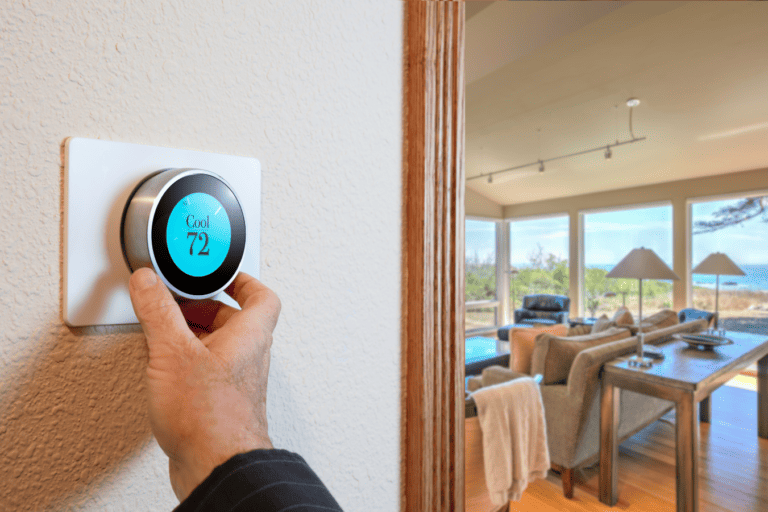7 Smart Ways Thermostats Reduce Energy Use
There are 7 Smart Ways Thermostats Reduce Energy Use. Smart thermostats have revolutionized how we manage our homes’ energy usage. These innovative devices are more than just a trend—they play a crucial role in energy conservation. As we strive to build more sustainable lifestyles, understanding how they work and their benefits becomes increasingly essential.
7 Smart Ways Thermostats Reduce Energy Use
- Optimized Energy Usage: Smart thermostats learn your routine and adjust the heating and cooling of your home accordingly. This prevents unnecessary energy consumption when no one is at home or when everyone is asleep.
- Remote Control: You can control smart thermostats using your smartphone, even when you are not at home. This means you can adjust your home’s temperature from anywhere, ensuring energy is not wasted.
- Maintenance Reminders: These devices can alert you when it’s time to change air filters or if there’s an issue with your HVAC system. Regular maintenance increases the efficiency of these systems, reducing energy usage.
- Zoned Heating and Cooling: Some smart thermostats can control different zones in your home. This means you can adjust the temperature for areas in use, while conserving energy in zones that aren’t.
- Detailed Energy Reports: Many smart thermostats provide detailed energy consumption reports. These insights can help you identify where and when you’re using the most energy, allowing you to make necessary adjustments.
- Integration with Other Smart Devices: Smart thermostats can work with other smart home devices. For instance, they can be synced with smart window blinds to control the amount of sunlight entering a room, thus balancing the temperature and saving energy.
- Adapting to Weather Changes: Smart thermostats can connect to local weather forecasts. By adjusting your home’s temperature in anticipation of weather changes, these devices can prevent unnecessary energy usage.
Smart thermostats revolutionize energy consumption in these ways, making your home more energy-efficient while maintaining comfort.
Brief Overview of Smart Thermostats
Smart thermostats are a step up from traditional ones. They allow for more control and provide insightful data about our energy habits. They are part of the broader ecosystem of innovative home technology, prioritizing efficiency and convenience.
Importance of Energy Conservation
The importance of energy conservation cannot be overstated. By reducing energy usage, we save on our electricity bills and contribute to reducing the strain on our planet’s resources.
The Role of Thermostats in Home Energy Usage
A thermostat’s primary function is to maintain a home’s temperature comfortably. It controls the heating or cooling systems based on your chosen temperature settings.
How it Influences Energy Usage in the Home
Your thermostat settings significantly influence your home’s energy usage. Higher settings in winter and lower ones in summer can result in excessive energy consumption. This is where smart thermostats come into play.
Smart Thermostats: A New Generation
Introduction to Smart Thermostats
Smart thermostats, like other smart home devices, are internet-connected devices that add a layer of control and intelligence to temperature management in your home. They allow you to remotely control your home’s heating and cooling and even learn your routine to optimize energy usage.
Key Features That Set Them Apart From Traditional Thermostats
Unlike traditional thermostats, smart thermostats offer programmability, learning capabilities, and interaction with other intelligent home devices. Some models provide detailed energy reports, helping you understand your consumption habits better.
How Smart Thermostats Conserve Energy
Detailed Explanation of Energy-Saving Features
Smart thermostats conserve energy in several ways. They allow you to set schedules and adjust the temperature when you’re away or asleep. Many also have learning capabilities, studying your habits over time and automatically adjusting the temperature accordingly. The remote control feature also allows you to change the temperature from anywhere, preventing unnecessary energy usage.
Real-Life Examples of Energy-Saving Outcomes
Numerous homeowners have seen substantial reductions in their energy bills after switching to intelligent thermostats. For example, a family in Texas reported a 20% reduction in their energy bill within two months of installing a smart thermostat.

The Environmental Impact of Using Smart Thermostats
Link Between Energy Usage and Environmental Impact
Energy production often involves burning fossil fuels, which contributes to climate change. Reducing energy consumption can reduce our carbon footprint and contribute to a healthier planet.
How Smart Thermostats Can Help Reduce Carbon Footprint
Smart thermostats can significantly reduce our homes’ carbon footprints by optimizing energy usage. They ensure we only use what we need, reducing waste and our environmental and ornamental impact.
Case Study: The Impact of Smart Thermostats on Household Energy Consumption
Studies have shown that smart thermostats can reduce household energy consumption by up to 23%. Another study found that households with programmable thermostats saved an average of $180 per year on their energy bills.
Smart Thermostats and the Future of Energy Conservation
Future Technologies in Smart Thermostats
As technology advances, we can expect even more features from smart thermostats, such as integration with renewable energy systems like solar panels. These advancements will likely make intelligent thermostats even more effective in conserving energy.
The Potential Role of These Advancements in Energy Conservation
As more homes adopt intelligent thermostats and other innovative home technologies, we’re likely to see a considerable reduction in overall energy consumption. This trend is encouraging for the future of energy conservation.Making the Switch to Smart Thermostats
Considerations When Buying a Smart Thermostat
Before purchasing a smart thermostat, consider your home’s compatibility, features, and ease of use. Review reviews and comparisons to ensure you choose the suitable machine.
Tips for Maximizing Energy Savings With a Smart Thermostat
To make the most of your smart thermostat, use the scheduling feature and allow the device to learn your habits. Regularly review your energy reports to understand and improve your consumption habits.
Smart thermostats have dramatically influenced energy consumption patterns in California. These cutting-edge devices, equipped with intelligent algorithms, sensors, and connectivity features, have redefined home energy management, leading to substantial energy conservation and minimized ecological impact.
California has always been a pioneer in implementing sustainable energy strategies, and adopting smart thermostats follows this trend. Initiatives such as the California Energy Commission’s “Energy Upgrade California” have advocated for adopting these devices, which has yielded encouraging outcomes.
These smart devices intuit the behavioral patterns of inhabitants and modulate temperatures accordingly, reducing wasteful energy usage in empty areas of the home.
Their remote accessibility allows users to adjust the home’s temperature settings from anywhere, thus curtailing unnecessary energy usage. They also provide detailed consumption data, empowering users to make knowledgeable energy consumption choices.
The energy savings have been considerable. A 2020 study from Nest Labs revealed that smart thermostats could lead to savings of up to 15% on cooling and 12% on heating expenses, translating to an average annual saving of $131 to $145 per household. Considering California’s population, this signifies a dramatic decrease in statewide energy consumption.
Beyond individual savings, smart thermostats have broader benefits for California’s power infrastructure. They help mitigate peak demand during the extreme temperatures of summer and winter, avoiding brownouts and blackouts and supporting a more dependable energy system.
Significantly, smart thermostats have aided California’s stringent carbon reduction targets. By decreasing the energy demand for heating and cooling, these devices reduce reliance on fossil fuel-based power generation, assisting the state’s transition towards 100% renewable energy.
In summary, smart thermostats have contributed to reducing energy consumption in California. By enhancing energy efficiency and minimizing waste, they have reinforced California’s standing as a frontrunner in sustainable energy practices.
Conclusion
In conclusion, intelligent thermostats are crucial in reducing home energy consumption. Providing more control, valuable insights, and advanced features, they help us conserve energy and reduce our environmental impact.
The Age of the Smart Thermostat: A Tool for Energy and Cost Efficiency
In today’s digital world, the rise of smart technologies, including the Internet of Things (IoT), has revolutionized our everyday lives. One of these technological advancements that has been making its way into homes worldwide is the smart thermostat. But what is a smart thermostat? A smart thermostat is a device designed for home automation that manages heating or air conditioning. It does this by learning from your habits, local weather conditions, and your preferred temperature settings, among other factors, optimizing the energy use of your HVAC system and ensuring comfort throughout the day.
A question often arises regarding energy consumption: how do smart thermostats save energy? Smart thermostats save energy by using intelligent algorithms to learn your daily routine and preferences, adjusting your heating and cooling systems accordingly. This smart adaptation means you’re using just the right amount of energy at the right time, significantly reducing energy waste.
This leads us to the next question, do smart thermostats save money? If we were to glance at the numerous discussions on platforms like Reddit, the common consensus seems to be affirmative. When smart thermostats save energy, they, in turn, reduce your utility bills, leading to savings in the long run. There are many “do smart thermostats save money? Reddit” discussions where users have shared their experiences and seen significant savings on their energy bills after installing smart thermostats.
However, understanding the precise savings can sometimes be a complex task. Thankfully, tools such as a smart thermostat savings calculator can help. These calculators consider factors like your current energy usage, the type of heating and cooling systems you use, and the climatic conditions in your area to provide an estimated amount of potential savings.
Finally, considering the many smart thermostats on the market today, identifying the best one can be quite a challenge. Several factors come into play, such as ease of installation, user interface, compatibility with your HVAC system, and cost. Top contenders often mentioned include Nest, Ecobee, and Honeywell, each with unique features and benefits.
In conclusion, intelligent thermostats are innovative devices that save energy and reduce monthly utility bills. Whether you’re tech-savvy or just looking for ways to make your home more energy-efficient, a smart thermostat could be a worthwhile investment.
Call to Action
Ready to make the switch to a smart thermostat? Check out our review of the 5 Best Thermostats on Earth Friendly Items. You’ll find comprehensive information to help you make an informed decision.
References
FAQs
- Do smart thermostats save money?
- Yes, smart thermostats can significantly reduce your energy bills by optimizing your home’s temperature based on your habits and preferences.
- Can smart thermostats work with any heating or cooling system?
- Most smart thermostats are compatible with standard home heating and cooling systems, but checking before purchasing is always a good idea.
- How long does it take to install a smart thermostat?
- For most people, installing a smart thermostat takes 30 minutes to an hour.
Let’s take control of our energy consumption and make more sustainable choices for our planet. After all, every little step counts towards a brighter future!
We’re reader-supported. We may earn an affiliate commission when you buy through links on our site.






